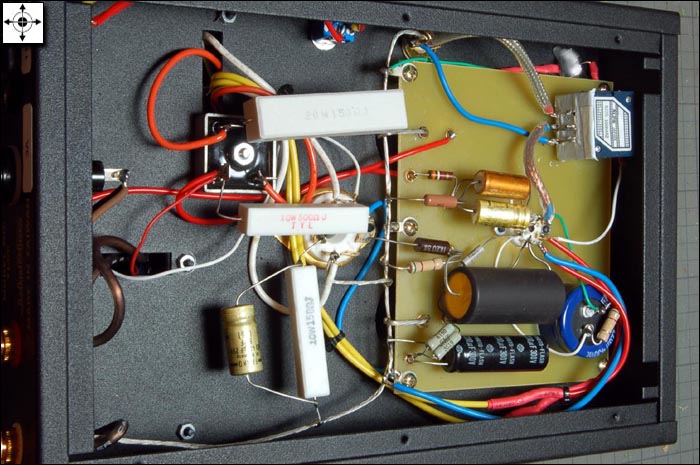This review page is supported in part by the sponsors whose ad banners are displayed below |
 |
 |
Tommy evaded a direct explanation. "Basically your question touches upon what could be a technical secret. Let’s call it the art of voicing. In most cases, a normal output transformer will deliver all the sound to the speaker. When we wind our transformer, we don’t. Imagine a main water pipe. Instead of installing just one faucet, we add two self-piercing needle valves and re-distribute the flow through ‘two other outlets’. When you touch the volume knob, you might feel some resonating movement. If you stick your ear up close, you might even hear some music. From our experience, the speaker will deliver richer overtones with such a voicing technique. Some tube amps’ transformers are tightly sealed in a casing filled with anti-resonant material but we find that kind of design offers less interesting harmonics. Likewise for vacuum tubes. The glass needs to resonate to enhance overtones."
|
|
|
I knew exactly what Tommy was saying. I have a friend who overdamped his tubes with rings of silver gel and the music became lifeless. But I also knew that one of the 6AU6 was showing early symptoms of imminent death. Over the next months, the problematic valve developed occasional noise. Without prompting, Tommy suddenly sent me two pairs of NOS 6AU6 which solved the issue lickety-spit. I was back in the magical world of valve bloom and hooked the monos to my favorite Klipsch Synergy F2 for even richer bass. In the meantime, my inquisitive nature urged me to learn more about the 6AU6. Instead of squeezing Tommy for more trade secrets, I decided to get a second opinion from Toronto tube guru Daniel Ho of Tube de Force. And I was bad. I deliberately put the problematic 6AU6 back in and sent him the monoblocks for a weekend.

The health report came back with the following remarks:
1. Due to faulty 6AU6 as input amplifier stage, one monoblock had hum which can be readily remedied with a good tube.
2. Audition: Typical pentode (beam tetrode) tube aura and warmth, rich in midrange and bass.
3. Bench test was performed after 1 hour warm-up for both monos arriving at the following measurements: Rated output 6.2 watts RMS, S/N better than 70dB, distortion 2 to 3%, frequency response 20Hz to 20kHz -1dB, 13Hz to 33kHz -3dB.
That was an impressive report card whose measurements were slightly better than claimed. Daniel followed up with a phone call and further explained the opportunities and risks of the design: "To achieve the ‘Leak’ sound, they use pentode or beam tetrodes in single-ended mode. This has an Achilles’ heel. High distortion as much as 10% is the norm and must rely on a high-gain open-loop circuit to minimize distortion. However, high gain opens the door to hum and requires careful administering of negative feedback. There are a number of good tube choices for the input amplifier. The very early productions of the 6FJ7 and 6FH7 are big 8-pin units like a 6L6 but hard to find. The more readily available 6AU6 are small 7-pin tubes equivalent to the EF94. The small 9-pin EF86 are now supplied by Tungsol but twice the cost of a 6AU6."
|
|
|
Tommy had already leaked to me his Leak story behind the model’s TL suffix: "I bought a pair of vintage Leak TL12.1 monoblocks by accident. That’s the best tube amp I’ve ever heard, period. So I decided to make a 6L6 tube amp that could emulate the Leak but it’s definitely not a clone since the circuitry and tubes are totally different. I think the musical quality is at least 90% comparable. I also tried to capture the same look and feel with the original yellow-bronze chassis and small longitudinal footprint although I knew such packaging might lack mass appeal. The circuit of the TL66 is extremely simple. I even eliminated the rectifier tube and used a bridge rectifier – simple and direct."

The fewer components, the greater their influence on overall sonics. According to Tommy, nothing was left to chance. "All resistors are audio-grade with 1% EIA and carefully matched for each pair of monoblocks. The coupling capacitor dictates the overall style and resolution and I trust nothing but my own handmade versions. The feedback resistor is another determining factor and the rating has been meticulously measured and auditioned. The ground wire contains 6% silver. The output transformer is a KEL made by Mr. K. E. Lee who has more than 30 years of experience designing audio-grade transformers but perhaps is better known as the inventor of Litz wire and the creator of the Calix Phoenix hornspeakers. The power transformer is custom-made industrial grade to meet American and European requirements. The speaker binding posts are my own fine-copper production. The IEC power inlet is gold plated. The power switch has silver contacts. Fuses are British made and only those that satisfy our stringent tests will be inserted into the amps."
|
 |
|
 |
|